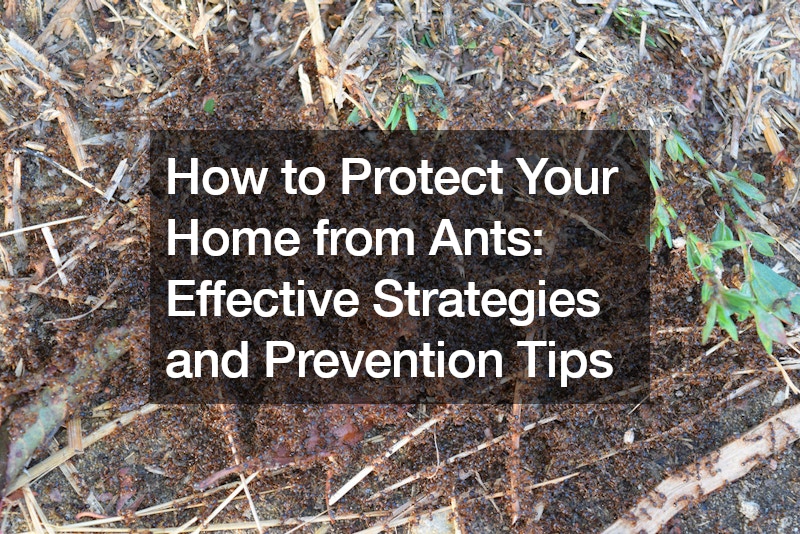Ant invasions can quickly turn your cozy home into a battleground. These tiny pests are not only a nuisance but can also cause structural damage and contaminate your food. Fortunately, with proactive measures and strategic planning, you can safeguard your home against ant infestations. Here’s a comprehensive guide on how to protect your home from ants, incorporating expert advice and practical tips.
Identifying Ants
The first step in ant control is accurate identification. Many people mistake ants for termites, but there are distinct differences.
Ants have long legs, bent antennae, and a segmented body with a slender waist. Additionally, their wings are shorter than those of termites, with the back wings smaller than the front. Understanding these characteristics can help you differentiate between the two pests and implement targeted eradication methods.
Elimination Techniques
Bait Traps:
Bait traps are a highly effective method for indoor ant control as they target entire colonies. Utilize both carb-based and protein-based baits to attract a wide variety of ants. Place traps near drains, in cabinets, and under appliances, but avoid placing them directly in the ants’ trails. Regularly check and replace bait traps to ensure continuous effectiveness.
Here are some key points to consider:
Monitoring Trap Activity: Regularly inspecting bait traps is essential to gauge their effectiveness. Check the traps periodically to see if they are attracting ants. You may notice ants swarming around the traps, indicating that they are actively seeking out the bait.
Examine Bait Consumption: Ants feed on the bait inside the traps, so observing the level of bait consumption can help determine when to replace them. If you notice a significant reduction in bait or if the traps appear empty, it’s time for a replacement.
Inspect Trap Condition: Assess the condition of the bait traps during your routine checks. Over time, the bait may dry out or become less appealing to ants. Additionally, traps can become dirty or contaminated, reducing their effectiveness. Replace traps that are damaged, dirty, or have expired bait.
Non-Repellent Sprays
Non-repellent sprays are ideal for treating surfaces indoors. While they may not kill ants immediately, they allow the pests to spread the treatment throughout the colony, leading to long-term eradication. Focus on spraying along baseboards, door frames, windows, and other entry points.
Outdoor Treatment
Outdoor ant populations must also be managed to prevent them from infiltrating your home. Liquid bait and granules can be strategically placed along ant trails to capture a diverse range of species. Use non-repellent sprays around the perimeter of your yard, focusing on structures and entry points.
Natural Remedies
Natural treatments such as diatomaceous earth and Borax offer non-toxic alternatives for ant control. Diatomaceous earth lacerates ants’ exoskeletons, leading to dehydration, while Borax acts as an odorless and low-toxicity solution. Food-based repellents are also effective and safe for use around pets and children.
Prevention Measures
Maintain Cleanliness:
Keep your home clean and free of food debris that may attract ants. Regularly wipe down kitchen surfaces, appliances, and trash cans. Store food in sealed containers or the refrigerator to minimize access for ants.
Eliminate Entry Points:
Seal cracks, gaps, and openings in walls, windows, and doors to prevent ants from entering your home. Repair damaged screens and ensure that door sweeps are intact.
Here’s a comprehensive list of potential entry points for ants:
Cracks in Foundation: Inspect the foundation of your home for any cracks or gaps where ants could enter. Seal these openings with caulk or concrete filler to prevent ant infiltration.
Gaps Around Pipes and Wires: Ants can enter your home through gaps around pipes, wires, and utility lines. Seal these entry points with expanding foam or silicone caulking to create a barrier against ant intrusion.
Vents and Chimneys: Check vents and chimney openings for gaps or cracks that ants could use as entry points. Install mesh screens or covers to prevent ants from entering through these openings while still allowing proper ventilation.
Window and Door Frames: Inspect window and door frames for gaps or gaps where ants could enter. Use weather stripping or silicone caulking to seal any gaps and ensure a tight seal.
Siding and Exterior Cladding: Ants may find their way into your home through gaps in siding or exterior cladding. Inspect these areas for gaps or loose panels and repair or replace them as needed to prevent ant entry.
Utility Access Points: Ants can also enter your home through utility access points, such as electrical outlets, HVAC vents, and cable entry points. Use sealants or covers specifically designed for these openings to prevent ant infiltration.
Garage and Basement Entry Points: Check garage doors, basement windows, and access doors for any gaps or openings that ants could use to enter your home. Install door sweeps, weather stripping, or thresholds to seal these entry points effectively.
Address Moisture Issues
Ants are attracted to moisture, so repair leaks and drips promptly. Keep sinks and tubs dry, empty drip pans, and wring out washcloths and sponges to eliminate potential nesting sites.
Outdoor Maintenance
Trim bushes, low branches, and vegetation away from your home’s exterior to create a barrier against ants. Clear debris, such as grass, leaves, and wood piles, and maintain gutters to prevent ant harborage.
When to Seek Professional Help
While DIY methods can be effective for minor ant infestations, severe or recurring problems may require professional intervention. Consider consulting with a licensed exterminator for the following scenarios:
Large Infestations:
If the ant population is overwhelming or widespread throughout your home, professional exterminators have the expertise and resources to address the issue comprehensively.
Persistent Infestations:
If ant control efforts prove ineffective despite your best efforts, professional exterminators can implement specialized treatments tailored to your home’s unique needs.
Structural Damage:
Ant infestations can cause structural damage over time, compromising the integrity of your home. Professional exterminators can assess the extent of the damage and recommend appropriate repairs.
In conclusion, protecting your home from ants requires a combination of preventive measures, effective elimination techniques, and, in some cases, professional intervention. By implementing these strategies and remaining vigilant, you can keep your home safe, comfortable, and free from pesky ant invaders.
.






